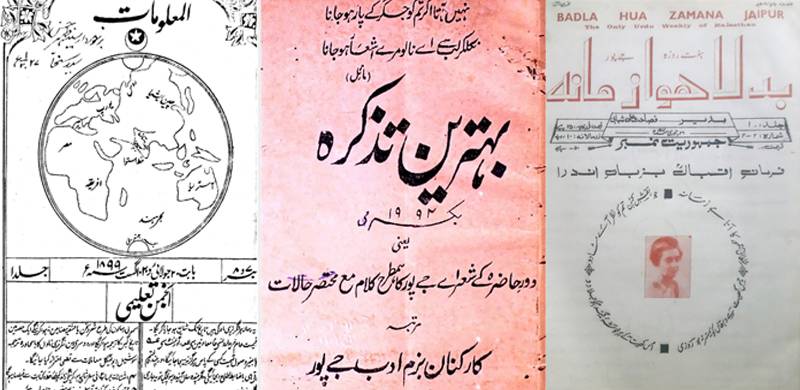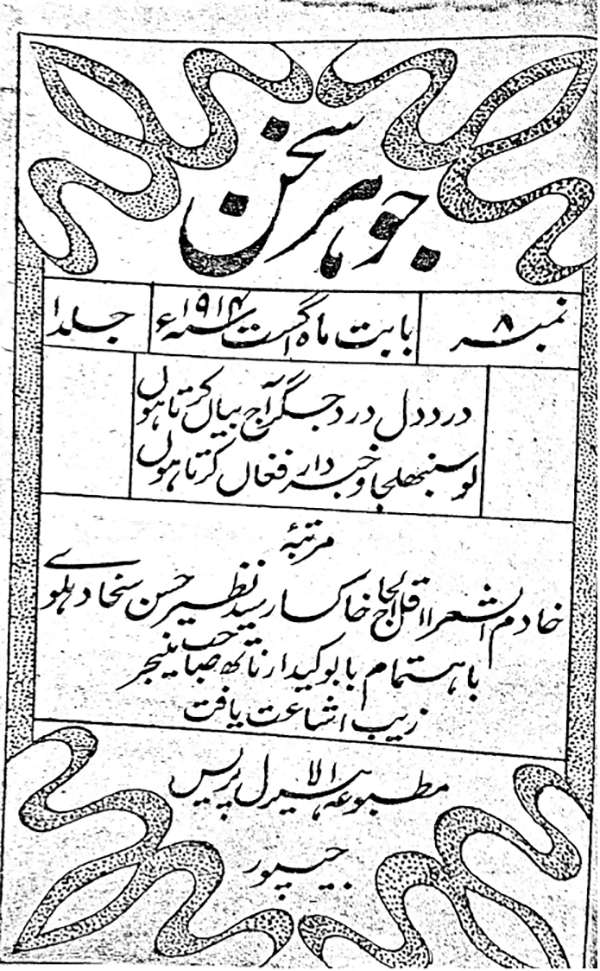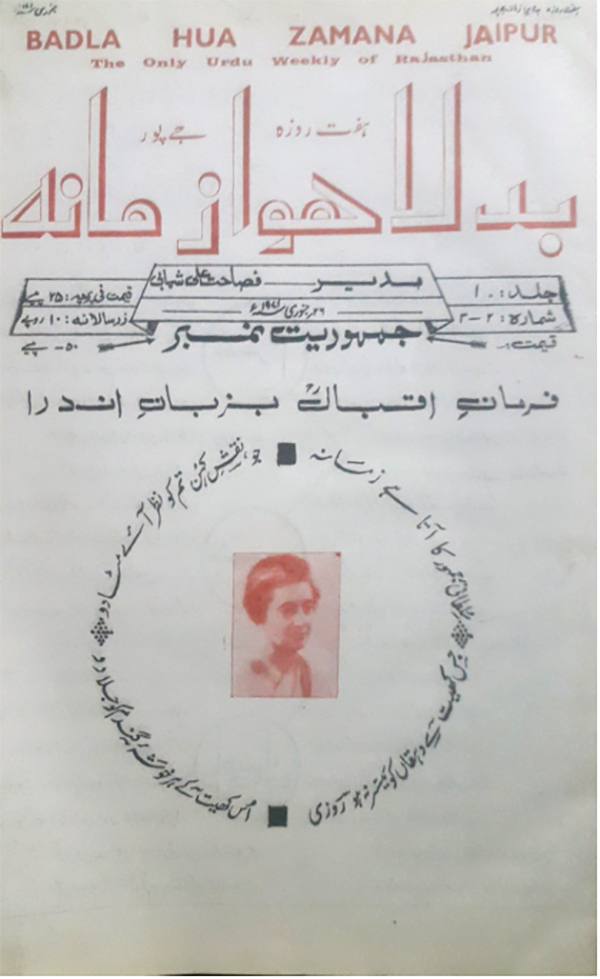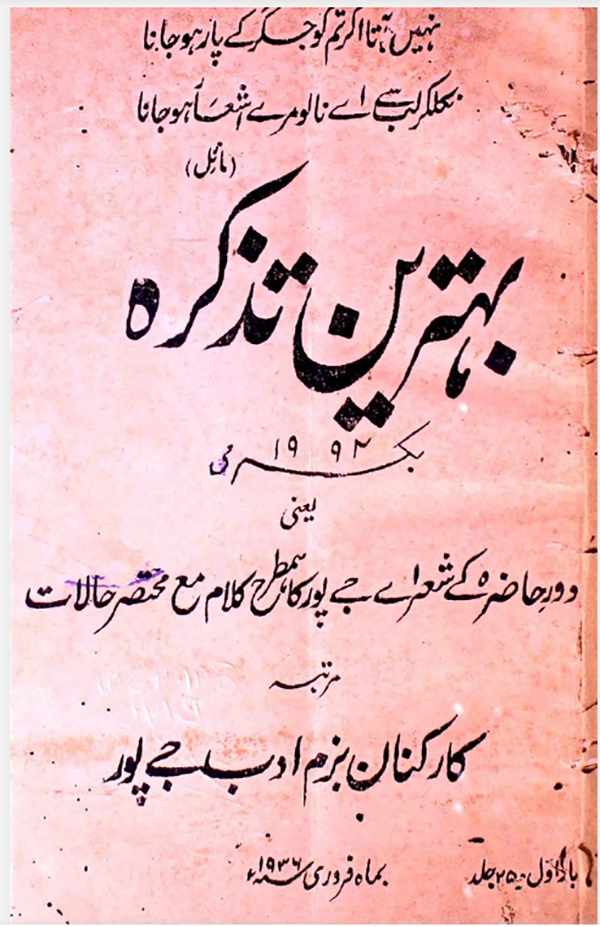
In this article, Syed Faizan Raza is explaining the history of Urdu literary societies, newspapers and magazines in the city of Jaipur, which became a major centre of Urdu literature after the fall of Mughal rule in Delhi as the local rulers of the princely state patronised arts and culture, making Jaipur a new home of Urdu poetry.
Jaipur, of late, emerged as one of the major focal points of the Urdu literature and welcomed a galaxy of poets who fled Delhi in the wake of the mutiny of 1857. The eminent bards who bade adieu to Delhi and found their abode in Jaipur included Zaheer Dehlavi, Anwar Dehlavi, Meer Mehdi Majrooh, Qamruddin Raqim, Mirza Abbas Beg Mahshar (disciple of legendary Shah Naseer) and Mail Dehlavi, among others. The predilection of the local rulers towards art and literature gave them financial stability and social recognition and, shortly, a glittering literary fabric wove its network across the city, which became illustrious as ‘Second-Delhi’.
The first Urdu society of Jaipur, Rajputana Social Science Congress, was established in 1869 under the patronage of the then ruler Maharaja Sawai Ram Singh. Its press published an eponymous newspaper on every Friday; and Faiz Muhammad Khan, the Prime Minister of Jaipur, honored the publication with his tenacious services. It was followed by Bazm-e-Adab and Maulana Tasleem was designated as its President. Munshi Kundan Lal Munshi had compiled the proceedings of twenty five Mushairas, held under the aegis of society from 1872 to 1874, and published in ‘Farhat-us Sho’ara’.
The third in the row was Bazm-e-Ahbaab (1890). Maulana Siraj-uddin Ahmad Kintoori was its Secretary. It had an attached library (Kutub Khana-e-Ahbaab) which stocked a large number of books on myriad of themes.

Islamic Panchayat came into existence in 1926. Its sole objective was to facilitate education among the Muslims, although, even non-Muslims were gladly received in its fold. Initially, it established a seminary which was elevated to a lower school and eventually a high school in 1945. The society got rechristened as Anjuman-e-Taleem-ul Muslimeen on 8th March 1945. In 1957, it was operating with a high school, lower middle school and girls’ school. Khan Bahadur Altaf Ahmad Sahab Khairi, a member of the elite Rajasthan Administrative Service, was its then President. It commenced the printing of a monthly magazine titled Roshni on first January 1935; and Maulvi Saeed Hussain Khan, head master of the middle school, was entrusted with the position of its editor. It would be worthwhile to remark at this point that it was Maulvi Ameeruddin Khan Shokh who was the de facto spearheader of the society and its various activities and engagements until 1944.
In 1934, a separate branch of Bazm-e-Adab was established and Maulana Athar became its Secretary. It wasn’t a doddle for Maulana to assume the coveted post as the prevailing circumstances crafted a crevice between him and Qazi Tanweer. Their adherents designed two factions which, in different meetings, selected their respective heads. Qazi Tanweer led Bazm-e-Adab which organized several Mushairas and proved more successful than the other. Musheer-e-Rajasthan and Shair (Agra) published the proceedings of the aforementioned rendezvouses. Besides these, the society published a few Guldastas and ‘Behtareen Tazkirah’ (1936) also. In the same year, Syed Zakir Hussain Asr founded Adabi Sabha which ceased to exist in his lifetime only. The year 1934 saw the establishment of Literary Corporation also which was fashioned by a handful of young and educated intelligentsia of Jaipur. Qazi Masroor Ahmad Siddiqui Tauqeer was at the helm of society and performed the duties of a President. Shaikh Mashkoor Ali Barq was its Secretary. The society arranged many a successful literary program under its banner including Nazeer Ahmad Day which was held on the campus of the Maharaja College; and a souvenir, ‘Yaadgar-e-Nazeer’ carried out its niceties.

Modern Poets Society was also formed in 1934; and its Secretary Rasheed Ahmad Ahmar continued to conduct Mushairas until 1958.
All the rendezvouses came to a cessation in the aftermath of the partition of the country, which witnessed a large chunk of the Jaipur’s elites fleeing to a new country, and the status quo prevailed until 26th March 1953 when a proposal to set up a branch of Anjuman-e-Taraqqi-e-Urdu Hind (Aligarh) was put forward. Khan Bahadur Altaf Ahmad was selected as its President and Ehtaramuddin Ahmad Shaghil as Secretary. The society organised a few Mushairas (in the haveli of Nawab Mukarram Ali Khan Mukarram at Tripolia Bazaar) on the eve of the Independence Day, but its main objective was to cater to the constructive and basic commitments which included foundation of schools in Jaipur. It was successful in launching a newspaper also, Nayee Roshni, in 1955.
Quite a few societies – Rajputana Urdu Research Academy, Bazm-e-Qamar, Bazm-e-Qirtaas-o-Qalam, Bazm-e-Kausar, Bazm-e-Rahat, Bazm-e-Rafiq and Adab Nawaz group – are still functioning in the city and endeavoring to relay the former splendor and legacy.
Urdu Newspapers and Magazines
Neer Rajasthan was the first weekly newspaper of Jaipur which came into being in 1865 and Hakeem Saleem Khan Khasta was its editor. Celebrated French author, Garcon de Tassi, had also received limited editions of the newspaper through his friend, E. H. Palmer.

It was followed by two weeklies – Rajputana Social Congress (1869) and Zikr-ul-Habeeb (1886).
Next to appear on the horizon was Al-bayan (1887) which lasted for one and half years. Bhargav Patrika emerged in 1888. In 1892, Bazm-e-Ahbaab launched Tafreeh-e-Ahbaab which was a literary magazine; instead of the conventional printing, the calligrapher would compose several copies and dispense among the members of society which made it accessible to a selected audience only. Al-maloomaat, a monthly journal, was started in 1899 under the editorship of Maulvi Vilayat Ahmad, who had rendered Urdu translation to ‘Qadeem Hindustan Ki Tahzeeb’; it continued for four years and turned out to be prominent among the literati. Nairang-e-Jahan, a monthly, was also conceived in 1899.
Monthly Qaum, edited by Maulvi Asasuddin Ahmad Tasneem, was started in 1901 and survived till 1919. In between it had to close its operation on several occasions. It published standard contents and had a satisfying circulation and readership, but not to an extent that it could sustain itself. Munshi Moinuddin Quraishi and Maulvi Ehtaramuddin Shaghil had stocked some of the copies of Qaum as their prized possessions.

In June 1906, Al-kamaal, which was a monthly journal, initiated its publication. It was jointly bowdlerized by Hakeem Syed Vahid Ali Khan Maseeh and Munshi Abdul Hameed Akhgar; but it couldn’t bring out more than three editions and eventually collapsed. The magazine had the honor to publish extracts of the Mushairas held in Moti Katra. Jauhar-e-Sukhan began on first January 1914 but couldn’t prolong for even one year. It published selection of the verses recited in different literary meetings of Jaipur and, to serve the purpose, a review committee including Maulana Sakha, Athar, Tasneem, Kausar, Jauhar, Siraj, Tanweer and Syed Bismil was constituted. It was the mouthpiece of Bazm-e-Adab and edited by Syed Nazeer Hasan Sakha Dehlavi. Jauhar-e-Sukhan was followed by Shadmaan (1925), emended by Hakeem Nurul Hussain Siddiqui; it closed either in 1926 or 1927.
Badruddin Goyal also called Badri Narayan had started a monthly, Iqbal, which could release only one edition and closed down. In 1945, Muhammad Taseen Shah Zaheen (who, in the wake of partition, had shifted to Karachi and become the concierge of the mausoleum of Abdul Kareem Shah Taji) began a monthly journal – Mashriq – which ceased publication after a few issues (earlier he published Bazm-e-Rajasthan).
The present scenario of Urdu journalism in the city is rather gloomy as only a few publications – Missile Express, Rajasthan Leader, Hamari Taqat, Istifsaar, and Nakhlistaan – are heading the movement. A resurgence of interest, towards the language, among the public is the need of the hour and this would serve as a suitable apparatus to pay a graceful tribute to the stalwarts who established and ran the enterprises despite grievous hardships.
Jaipur, of late, emerged as one of the major focal points of the Urdu literature and welcomed a galaxy of poets who fled Delhi in the wake of the mutiny of 1857. The eminent bards who bade adieu to Delhi and found their abode in Jaipur included Zaheer Dehlavi, Anwar Dehlavi, Meer Mehdi Majrooh, Qamruddin Raqim, Mirza Abbas Beg Mahshar (disciple of legendary Shah Naseer) and Mail Dehlavi, among others. The predilection of the local rulers towards art and literature gave them financial stability and social recognition and, shortly, a glittering literary fabric wove its network across the city, which became illustrious as ‘Second-Delhi’.
The first Urdu society of Jaipur, Rajputana Social Science Congress, was established in 1869 under the patronage of the then ruler Maharaja Sawai Ram Singh. Its press published an eponymous newspaper on every Friday; and Faiz Muhammad Khan, the Prime Minister of Jaipur, honored the publication with his tenacious services. It was followed by Bazm-e-Adab and Maulana Tasleem was designated as its President. Munshi Kundan Lal Munshi had compiled the proceedings of twenty five Mushairas, held under the aegis of society from 1872 to 1874, and published in ‘Farhat-us Sho’ara’.
Also read: The history of Urdu printing press in Jaipur
The third in the row was Bazm-e-Ahbaab (1890). Maulana Siraj-uddin Ahmad Kintoori was its Secretary. It had an attached library (Kutub Khana-e-Ahbaab) which stocked a large number of books on myriad of themes.

Al-maloomaat, 20 July – 20 August 1899
In 1957, it was operating with a high school, lower middle school and girls’ school. Khan Bahadur Altaf Ahmad Sahab Khairi, a member of the elite Rajasthan Administrative Service, was its then President. It commenced the printing of a monthly magazine titled Roshni on first January 1935; and Maulvi Saeed Hussain Khan, head master of the middle school, was entrusted with the position of its editor.
Islamic Panchayat came into existence in 1926. Its sole objective was to facilitate education among the Muslims, although, even non-Muslims were gladly received in its fold. Initially, it established a seminary which was elevated to a lower school and eventually a high school in 1945. The society got rechristened as Anjuman-e-Taleem-ul Muslimeen on 8th March 1945. In 1957, it was operating with a high school, lower middle school and girls’ school. Khan Bahadur Altaf Ahmad Sahab Khairi, a member of the elite Rajasthan Administrative Service, was its then President. It commenced the printing of a monthly magazine titled Roshni on first January 1935; and Maulvi Saeed Hussain Khan, head master of the middle school, was entrusted with the position of its editor. It would be worthwhile to remark at this point that it was Maulvi Ameeruddin Khan Shokh who was the de facto spearheader of the society and its various activities and engagements until 1944.
In 1934, a separate branch of Bazm-e-Adab was established and Maulana Athar became its Secretary. It wasn’t a doddle for Maulana to assume the coveted post as the prevailing circumstances crafted a crevice between him and Qazi Tanweer. Their adherents designed two factions which, in different meetings, selected their respective heads. Qazi Tanweer led Bazm-e-Adab which organized several Mushairas and proved more successful than the other. Musheer-e-Rajasthan and Shair (Agra) published the proceedings of the aforementioned rendezvouses. Besides these, the society published a few Guldastas and ‘Behtareen Tazkirah’ (1936) also. In the same year, Syed Zakir Hussain Asr founded Adabi Sabha which ceased to exist in his lifetime only. The year 1934 saw the establishment of Literary Corporation also which was fashioned by a handful of young and educated intelligentsia of Jaipur. Qazi Masroor Ahmad Siddiqui Tauqeer was at the helm of society and performed the duties of a President. Shaikh Mashkoor Ali Barq was its Secretary. The society arranged many a successful literary program under its banner including Nazeer Ahmad Day which was held on the campus of the Maharaja College; and a souvenir, ‘Yaadgar-e-Nazeer’ carried out its niceties.

Jauhar-e-Sukhan, August 1914, published by Hira Lal Press Jaipur
Modern Poets Society was also formed in 1934; and its Secretary Rasheed Ahmad Ahmar continued to conduct Mushairas until 1958.
The society organised a few Mushairas (in the haveli of Nawab Mukarram Ali Khan Mukarram at Tripolia Bazaar) on the eve of the Independence Day, but its main objective was to cater to the constructive and basic commitments which included foundation of schools in Jaipur.
All the rendezvouses came to a cessation in the aftermath of the partition of the country, which witnessed a large chunk of the Jaipur’s elites fleeing to a new country, and the status quo prevailed until 26th March 1953 when a proposal to set up a branch of Anjuman-e-Taraqqi-e-Urdu Hind (Aligarh) was put forward. Khan Bahadur Altaf Ahmad was selected as its President and Ehtaramuddin Ahmad Shaghil as Secretary. The society organised a few Mushairas (in the haveli of Nawab Mukarram Ali Khan Mukarram at Tripolia Bazaar) on the eve of the Independence Day, but its main objective was to cater to the constructive and basic commitments which included foundation of schools in Jaipur. It was successful in launching a newspaper also, Nayee Roshni, in 1955.
Quite a few societies – Rajputana Urdu Research Academy, Bazm-e-Qamar, Bazm-e-Qirtaas-o-Qalam, Bazm-e-Kausar, Bazm-e-Rahat, Bazm-e-Rafiq and Adab Nawaz group – are still functioning in the city and endeavoring to relay the former splendor and legacy.
Urdu Newspapers and Magazines
Neer Rajasthan was the first weekly newspaper of Jaipur which came into being in 1865 and Hakeem Saleem Khan Khasta was its editor. Celebrated French author, Garcon de Tassi, had also received limited editions of the newspaper through his friend, E. H. Palmer.

Badla Hua Zamana, 26 January 1971
It was followed by two weeklies – Rajputana Social Congress (1869) and Zikr-ul-Habeeb (1886).
In 1892, Bazm-e-Ahbaab launched Tafreeh-e-Ahbaab which was a literary magazine; instead of the conventional printing, the calligrapher would compose several copies and dispense among the members of society which made it accessible to a selected audience only.
Next to appear on the horizon was Al-bayan (1887) which lasted for one and half years. Bhargav Patrika emerged in 1888. In 1892, Bazm-e-Ahbaab launched Tafreeh-e-Ahbaab which was a literary magazine; instead of the conventional printing, the calligrapher would compose several copies and dispense among the members of society which made it accessible to a selected audience only. Al-maloomaat, a monthly journal, was started in 1899 under the editorship of Maulvi Vilayat Ahmad, who had rendered Urdu translation to ‘Qadeem Hindustan Ki Tahzeeb’; it continued for four years and turned out to be prominent among the literati. Nairang-e-Jahan, a monthly, was also conceived in 1899.
Monthly Qaum, edited by Maulvi Asasuddin Ahmad Tasneem, was started in 1901 and survived till 1919. In between it had to close its operation on several occasions. It published standard contents and had a satisfying circulation and readership, but not to an extent that it could sustain itself. Munshi Moinuddin Quraishi and Maulvi Ehtaramuddin Shaghil had stocked some of the copies of Qaum as their prized possessions.

Behtareen Tazkirah, 1936
In June 1906, Al-kamaal, which was a monthly journal, initiated its publication. It was jointly bowdlerized by Hakeem Syed Vahid Ali Khan Maseeh and Munshi Abdul Hameed Akhgar; but it couldn’t bring out more than three editions and eventually collapsed. The magazine had the honor to publish extracts of the Mushairas held in Moti Katra. Jauhar-e-Sukhan began on first January 1914 but couldn’t prolong for even one year. It published selection of the verses recited in different literary meetings of Jaipur and, to serve the purpose, a review committee including Maulana Sakha, Athar, Tasneem, Kausar, Jauhar, Siraj, Tanweer and Syed Bismil was constituted. It was the mouthpiece of Bazm-e-Adab and edited by Syed Nazeer Hasan Sakha Dehlavi. Jauhar-e-Sukhan was followed by Shadmaan (1925), emended by Hakeem Nurul Hussain Siddiqui; it closed either in 1926 or 1927.
Badruddin Goyal also called Badri Narayan had started a monthly, Iqbal, which could release only one edition and closed down. In 1945, Muhammad Taseen Shah Zaheen (who, in the wake of partition, had shifted to Karachi and become the concierge of the mausoleum of Abdul Kareem Shah Taji) began a monthly journal – Mashriq – which ceased publication after a few issues (earlier he published Bazm-e-Rajasthan).
The present scenario of Urdu journalism in the city is rather gloomy as only a few publications – Missile Express, Rajasthan Leader, Hamari Taqat, Istifsaar, and Nakhlistaan – are heading the movement. A resurgence of interest, towards the language, among the public is the need of the hour and this would serve as a suitable apparatus to pay a graceful tribute to the stalwarts who established and ran the enterprises despite grievous hardships.
